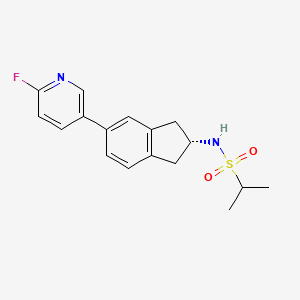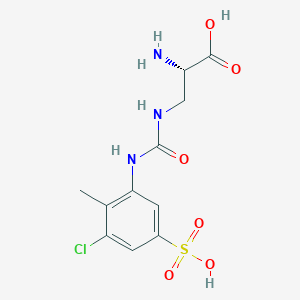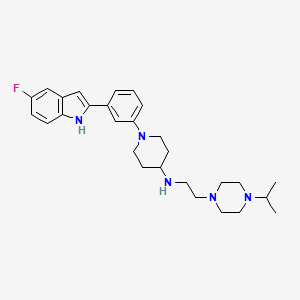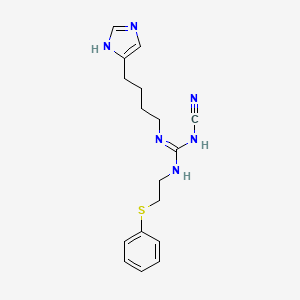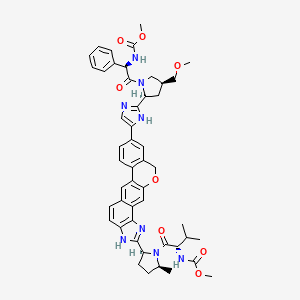
ベルパタビル
概要
説明
ベルパタビルは、ソフォスブビルとの併用でC型慢性肝炎ウイルス(HCV)感染症の治療に用いられる、直接作用型抗ウイルス薬です。HCVの6つの主要な遺伝子型すべてに効果があります。 ベルパタビルは、ウイルス複製とアセンブリに不可欠な非構造タンパク質5A(NS5A)の阻害によって作用します .
科学的研究の応用
Velpatasvir has several scientific research applications, including:
Chemistry: Used as a model compound to study the mechanisms of antiviral agents and their interactions with viral proteins.
Biology: Helps in understanding the replication and assembly of HCV, providing insights into viral life cycles.
Medicine: Widely used in clinical research to develop effective treatments for HCV infections. .
作用機序
ベルパタビルは、HCVの複製とアセンブリに不可欠なNS5Aタンパク質を阻害することで、その効果を発揮します。このタンパク質を阻害することによって、ベルパタビルはウイルスが複製して新しいウイルス粒子をアセンブリするのを防ぎます。 この阻害は、ウイルス量の減少につながり、患者における持続的なウイルス学的反応(SVR)の達成に役立ちます .
生化学分析
Biochemical Properties
Velpatasvir interacts with the NS5A protein, inhibiting its function and thereby preventing viral replication . It has a significantly higher barrier to resistance than the first generation NS5A inhibitors .
Cellular Effects
Velpatasvir has a profound effect on cells infected with the Hepatitis C Virus. By inhibiting the NS5A protein, Velpatasvir disrupts the virus’s ability to replicate and assemble within the cell . This leads to a reduction in viral load and can ultimately result in the eradication of the virus from the body .
Molecular Mechanism
The molecular mechanism of Velpatasvir involves its action as a defective substrate for the NS5A protein . This protein is essential for the replication and assembly of the Hepatitis C Virus. By binding to NS5A, Velpatasvir prevents it from functioning properly, thereby disrupting the life cycle of the virus .
Temporal Effects in Laboratory Settings
In laboratory settings, Velpatasvir has been shown to produce rapid and sustained viral suppression at all monotherapy dose levels in HCV-infected individuals .
Metabolic Pathways
Velpatasvir is metabolized in the liver by the enzymes CYP2B6, CYP2C8, and CYP3A4 . It is both an inhibitor and a substrate of the transporter proteins P-glycoprotein (Pgp), ABCG2, OATP1B1, and OATP1B3 .
Transport and Distribution
Velpatasvir is transported and distributed within cells and tissues via transporter proteins including P-glycoprotein (Pgp), ABCG2, OATP1B1, and OATP1B3 .
Subcellular Localization
The subcellular localization of Velpatasvir is not explicitly stated in the available literature. Given its mechanism of action, it is likely that it interacts with the NS5A protein in the cytoplasm where Hepatitis C Virus replication and assembly occur .
準備方法
合成経路と反応条件
ベルパタビルの合成は、容易に入手可能な出発物質から始まる、複数段階のプロセスです。 合成における重要な中間体の1つは、式5の化合物であり、さらにベルパタビルまたはその薬学的に許容される塩に変換されます . このプロセスには、制御された反応条件下で、ジメチルホルムアミド(DMF)と炭酸セシウムを含む、様々な試薬と溶媒を使用します .
工業生産方法
ベルパタビルの工業生産は、同様の合成経路に従いますが、大規模製造のために最適化されています。このプロセスは、最終製品の高収率と純度を確保します。 生産には、医薬品の品質と安全性を確保するための厳格な品質管理対策が含まれます .
化学反応の分析
反応の種類
ベルパタビルは、次を含むいくつかの種類の化学反応を起こします。
酸化: ベルパタビルは、特定の条件下で酸化されて、様々な酸化生成物を形成することができます。
還元: 還元反応を使用して、ベルパタビルの特定の官能基を修飾することができます。
置換: ベルパタビルは、1つの官能基が別の官能基に置換される置換反応を起こすことができます。
一般的な試薬と条件
これらの反応で使用される一般的な試薬には、過酸化水素などの酸化剤、水素化ホウ素ナトリウムなどの還元剤、置換反応を促進する様々な触媒が含まれます。 温度やpHなどの反応条件は、目的の生成物を得るために注意深く制御されます .
生成される主な生成物
これらの反応から生成される主な生成物は、使用される特定の反応条件と試薬によって異なります。 例えば、ベルパタビルの酸化は、ヒドロキシル化誘導体の形成につながる可能性があり、一方、還元は脱酸素化生成物を生じます .
科学研究への応用
ベルパタビルは、次を含むいくつかの科学研究への応用があります。
類似化合物との比較
ベルパタビルは、レディパスビルやダクラタズビルなどの他のNS5A阻害剤と比較されます。これらの化合物すべてがNS5Aタンパク質を阻害しますが、ベルパタビルは耐性へのバリアが高く、HCVの6つの主要な遺伝子型すべてに効果があります。 これは、慢性HCV感染症の治療のためのより強力で信頼性の高い選択肢となります .
類似化合物のリスト
- レディパスビル
- ダクラタズビル
- オムビタズビル
- エルバスビル
ベルパタビルのすべてのHCV遺伝子型を標的とする独自の能力と高い耐性バリアは、抗ウイルス薬の武器庫への貴重な追加となります .
特性
IUPAC Name |
methyl N-[(1R)-2-[(2S,4S)-2-[5-[6-[(2S,5S)-1-[(2S)-2-(methoxycarbonylamino)-3-methylbutanoyl]-5-methylpyrrolidin-2-yl]-21-oxa-5,7-diazapentacyclo[11.8.0.03,11.04,8.014,19]henicosa-1(13),2,4(8),5,9,11,14(19),15,17-nonaen-17-yl]-1H-imidazol-2-yl]-4-(methoxymethyl)pyrrolidin-1-yl]-2-oxo-1-phenylethyl]carbamate | |
|---|---|---|
| Source | PubChem | |
| URL | https://pubchem.ncbi.nlm.nih.gov | |
| Description | Data deposited in or computed by PubChem | |
InChI |
InChI=1S/C49H54N8O8/c1-26(2)41(54-48(60)63-5)47(59)57-27(3)12-17-38(57)45-51-36-16-14-30-20-35-33-15-13-31(19-32(33)25-65-40(35)21-34(30)43(36)53-45)37-22-50-44(52-37)39-18-28(24-62-4)23-56(39)46(58)42(55-49(61)64-6)29-10-8-7-9-11-29/h7-11,13-16,19-22,26-28,38-39,41-42H,12,17-18,23-25H2,1-6H3,(H,50,52)(H,51,53)(H,54,60)(H,55,61)/t27-,28-,38-,39-,41-,42+/m0/s1 | |
| Source | PubChem | |
| URL | https://pubchem.ncbi.nlm.nih.gov | |
| Description | Data deposited in or computed by PubChem | |
InChI Key |
FHCUMDQMBHQXKK-CDIODLITSA-N | |
| Source | PubChem | |
| URL | https://pubchem.ncbi.nlm.nih.gov | |
| Description | Data deposited in or computed by PubChem | |
Canonical SMILES |
CC1CCC(N1C(=O)C(C(C)C)NC(=O)OC)C2=NC3=C(N2)C=CC4=CC5=C(C=C43)OCC6=C5C=CC(=C6)C7=CN=C(N7)C8CC(CN8C(=O)C(C9=CC=CC=C9)NC(=O)OC)COC | |
| Source | PubChem | |
| URL | https://pubchem.ncbi.nlm.nih.gov | |
| Description | Data deposited in or computed by PubChem | |
Isomeric SMILES |
C[C@H]1CC[C@H](N1C(=O)[C@H](C(C)C)NC(=O)OC)C2=NC3=C(N2)C=CC4=CC5=C(C=C43)OCC6=C5C=CC(=C6)C7=CN=C(N7)[C@@H]8C[C@@H](CN8C(=O)[C@@H](C9=CC=CC=C9)NC(=O)OC)COC | |
| Source | PubChem | |
| URL | https://pubchem.ncbi.nlm.nih.gov | |
| Description | Data deposited in or computed by PubChem | |
Molecular Formula |
C49H54N8O8 | |
| Source | PubChem | |
| URL | https://pubchem.ncbi.nlm.nih.gov | |
| Description | Data deposited in or computed by PubChem | |
DSSTOX Substance ID |
DTXSID70722565 | |
| Record name | Velpatasvir | |
| Source | EPA DSSTox | |
| URL | https://comptox.epa.gov/dashboard/DTXSID70722565 | |
| Description | DSSTox provides a high quality public chemistry resource for supporting improved predictive toxicology. | |
Molecular Weight |
883.0 g/mol | |
| Source | PubChem | |
| URL | https://pubchem.ncbi.nlm.nih.gov | |
| Description | Data deposited in or computed by PubChem | |
Mechanism of Action |
Velpatasvir's mechanism of action is likely similar to other selective NS5A inhibitors which bind domain I of NS5A consisting of amino acids 33-202. NS5A inhibitors compete with RNA for binding at this site. It is also thought that NS5A inhibitors bind the target during its action in replication when the binding site is exposed. Inhibition of NS5A is also known to produce redistribution of the protein to lipid droplets. The exact role of NS5A in RNA replication is not yet understood although it is known to be an important component. | |
| Record name | Velpatasvir | |
| Source | DrugBank | |
| URL | https://www.drugbank.ca/drugs/DB11613 | |
| Description | The DrugBank database is a unique bioinformatics and cheminformatics resource that combines detailed drug (i.e. chemical, pharmacological and pharmaceutical) data with comprehensive drug target (i.e. sequence, structure, and pathway) information. | |
| Explanation | Creative Common's Attribution-NonCommercial 4.0 International License (http://creativecommons.org/licenses/by-nc/4.0/legalcode) | |
CAS No. |
1377049-84-7 | |
| Record name | Carbamic acid, N-[(1R)-2-[(2S,4S)-2-[5-[1,11-dihydro-2-[(2S,5S)-1-[(2S)-2-[(methoxycarbonyl)amino]-3-methyl-1-oxobutyl]-5-methyl-2-pyrrolidinyl][2]benzopyrano[4′,3′:6,7]naphth[1,2-d]imidazol-9-yl]-1H-imidazol-2-yl]-4-(methoxymethyl)-1-pyrrolidinyl]-2-oxo-1-phenylethyl]-, methyl ester | |
| Source | CAS Common Chemistry | |
| URL | https://commonchemistry.cas.org/detail?cas_rn=1377049-84-7 | |
| Description | CAS Common Chemistry is an open community resource for accessing chemical information. Nearly 500,000 chemical substances from CAS REGISTRY cover areas of community interest, including common and frequently regulated chemicals, and those relevant to high school and undergraduate chemistry classes. This chemical information, curated by our expert scientists, is provided in alignment with our mission as a division of the American Chemical Society. | |
| Explanation | The data from CAS Common Chemistry is provided under a CC-BY-NC 4.0 license, unless otherwise stated. | |
| Record name | Velpatasvir [USAN:INN] | |
| Source | ChemIDplus | |
| URL | https://pubchem.ncbi.nlm.nih.gov/substance/?source=chemidplus&sourceid=1377049847 | |
| Description | ChemIDplus is a free, web search system that provides access to the structure and nomenclature authority files used for the identification of chemical substances cited in National Library of Medicine (NLM) databases, including the TOXNET system. | |
| Record name | Velpatasvir | |
| Source | DrugBank | |
| URL | https://www.drugbank.ca/drugs/DB11613 | |
| Description | The DrugBank database is a unique bioinformatics and cheminformatics resource that combines detailed drug (i.e. chemical, pharmacological and pharmaceutical) data with comprehensive drug target (i.e. sequence, structure, and pathway) information. | |
| Explanation | Creative Common's Attribution-NonCommercial 4.0 International License (http://creativecommons.org/licenses/by-nc/4.0/legalcode) | |
| Record name | Velpatasvir | |
| Source | EPA DSSTox | |
| URL | https://comptox.epa.gov/dashboard/DTXSID70722565 | |
| Description | DSSTox provides a high quality public chemistry resource for supporting improved predictive toxicology. | |
| Record name | methyl N-[(1R)-2-[(2S,4S)-2-[5-[6-[(2S,5S)-1-[(2S)-2-(methoxycarbonylamino)-3-methylbutanoyl]-5-methylpyrrolidin-2-yl]-21-oxa-5,7-diazapentacyclo[11.8.0.03,11.04,8.014,19]henicosa-1(13),2,4(8),5,9,11,14(19),15,17-nonaen-17-yl]-1H-imidazol-2-yl]-4-(methoxymethyl)pyrrolidin-1-yl]-2-oxo-1-phenylethyl]carbamate | |
| Source | European Chemicals Agency (ECHA) | |
| URL | https://echa.europa.eu/information-on-chemicals | |
| Description | The European Chemicals Agency (ECHA) is an agency of the European Union which is the driving force among regulatory authorities in implementing the EU's groundbreaking chemicals legislation for the benefit of human health and the environment as well as for innovation and competitiveness. | |
| Explanation | Use of the information, documents and data from the ECHA website is subject to the terms and conditions of this Legal Notice, and subject to other binding limitations provided for under applicable law, the information, documents and data made available on the ECHA website may be reproduced, distributed and/or used, totally or in part, for non-commercial purposes provided that ECHA is acknowledged as the source: "Source: European Chemicals Agency, http://echa.europa.eu/". Such acknowledgement must be included in each copy of the material. ECHA permits and encourages organisations and individuals to create links to the ECHA website under the following cumulative conditions: Links can only be made to webpages that provide a link to the Legal Notice page. | |
| Record name | VELPATASVIR | |
| Source | FDA Global Substance Registration System (GSRS) | |
| URL | https://gsrs.ncats.nih.gov/ginas/app/beta/substances/KCU0C7RS7Z | |
| Description | The FDA Global Substance Registration System (GSRS) enables the efficient and accurate exchange of information on what substances are in regulated products. Instead of relying on names, which vary across regulatory domains, countries, and regions, the GSRS knowledge base makes it possible for substances to be defined by standardized, scientific descriptions. | |
| Explanation | Unless otherwise noted, the contents of the FDA website (www.fda.gov), both text and graphics, are not copyrighted. They are in the public domain and may be republished, reprinted and otherwise used freely by anyone without the need to obtain permission from FDA. Credit to the U.S. Food and Drug Administration as the source is appreciated but not required. | |
Retrosynthesis Analysis
AI-Powered Synthesis Planning: Our tool employs the Template_relevance Pistachio, Template_relevance Bkms_metabolic, Template_relevance Pistachio_ringbreaker, Template_relevance Reaxys, Template_relevance Reaxys_biocatalysis model, leveraging a vast database of chemical reactions to predict feasible synthetic routes.
One-Step Synthesis Focus: Specifically designed for one-step synthesis, it provides concise and direct routes for your target compounds, streamlining the synthesis process.
Accurate Predictions: Utilizing the extensive PISTACHIO, BKMS_METABOLIC, PISTACHIO_RINGBREAKER, REAXYS, REAXYS_BIOCATALYSIS database, our tool offers high-accuracy predictions, reflecting the latest in chemical research and data.
Strategy Settings
| Precursor scoring | Relevance Heuristic |
|---|---|
| Min. plausibility | 0.01 |
| Model | Template_relevance |
| Template Set | Pistachio/Bkms_metabolic/Pistachio_ringbreaker/Reaxys/Reaxys_biocatalysis |
| Top-N result to add to graph | 6 |
Feasible Synthetic Routes
Q1: What is the primary target of Velpatasvir?
A1: Velpatasvir specifically targets the hepatitis C virus (HCV) NS5A protein. [, , , , , ] This protein is essential for HCV replication, virion assembly, and modulation of the host cellular response. [, ]
Q2: How does Velpatasvir exert its antiviral activity?
A2: Velpatasvir inhibits the function of the HCV NS5A protein, a key player in viral replication and assembly. [, , , , , ] While the exact mechanism remains under investigation, it's believed that Velpatasvir binding disrupts critical protein-protein interactions within the viral replication complex. This effectively halts the production of new viral particles. [, ]
Q3: Does Velpatasvir exhibit activity against all HCV genotypes?
A3: Yes, Velpatasvir has demonstrated potent pangenotypic antiviral activity, meaning it is effective against all major HCV genotypes (genotypes 1-6). [, , , , ] This pangenotypic activity makes it a valuable therapeutic option, simplifying treatment decisions for clinicians. [, ]
Q4: What is the molecular formula and weight of Velpatasvir?
A4: The molecular formula of Velpatasvir is C45H57N7O8, and its molecular weight is 831.98 g/mol. []
Q5: Is there spectroscopic data available for Velpatasvir?
A5: While the provided research papers do not specify particular spectroscopic data for Velpatasvir, various analytical techniques are employed for its characterization. These include high-performance liquid chromatography (HPLC) coupled with ultraviolet (UV) detection, often at a wavelength of 260 nm. [, , ] Thin-layer chromatography (TLC) with fluorescence detection is another method used for its sensitive and selective determination, particularly in biological matrices like human plasma. []
Q6: How stable is Velpatasvir under various storage conditions?
A6: While specific stability data is not outlined in the provided research, various studies utilize stability-indicating analytical methods, suggesting that Velpatasvir's stability profile is well-characterized. [, , ] These methods, often involving RP-HPLC or HPTLC, are designed to separate and quantify Velpatasvir from potential degradation products, allowing for the assessment of its stability under different storage conditions (temperature, humidity, light exposure). [, , ]
Q7: What are some formulation strategies used to improve Velpatasvir's bioavailability?
A7: Velpatasvir is formulated as a fixed-dose combination tablet with Sofosbuvir. [, , ] While the specific excipients used are not detailed in the provided research, the formulation is designed for oral administration and optimized for once-daily dosing. [, , ] This fixed-dose combination simplifies treatment regimens and potentially improves patient adherence. [, , ]
Q8: What types of in vitro studies have been conducted to evaluate Velpatasvir's antiviral activity?
A8: Velpatasvir's antiviral activity has been extensively evaluated in vitro using HCV replicon cell lines. [, ] These cell lines harbor a subgenomic HCV replicon, which allows for the continuous replication of the viral RNA. By measuring the inhibition of viral replication in these cells, researchers can determine the potency and efficacy of Velpatasvir. [, ]
Q9: Has resistance to Velpatasvir been observed in clinical trials?
A10: Yes, resistance to Velpatasvir has been observed in clinical trials, particularly in patients infected with HCV genotype 3 or those with pre-existing resistance-associated substitutions (RASs). [, , , ] These substitutions typically occur in the NS5A region of the HCV genome and can reduce the binding affinity of Velpatasvir to its target, leading to decreased drug efficacy. [, , , ]
Q10: What are the most common resistance-associated substitutions (RASs) for Velpatasvir?
A11: The most common RASs for Velpatasvir are found in the NS5A protein, with variations depending on the HCV genotype. For genotype 1a, common substitutions include M28G, A92K, and Y93H/N/R/W. In genotype 1b, the A92K substitution is frequently observed. [] Notably, the Y93H substitution can arise across multiple genotypes (1a, 1b, 2a, 3a, 4a). [] Genotype 6a exhibits distinct RASs, such as L31V and P32A/L/Q/R, which confer high-level resistance. [] The emergence of L31V in genotype 6a can further facilitate the development of resistance to Pibrentasvir via the emergence of L28S. []
Q11: Are there any specific biomarkers or diagnostics used in relation to Velpatasvir therapy?
A12: The primary biomarker for monitoring the effectiveness of Velpatasvir therapy is the HCV RNA level in the blood. Achieving a sustained virologic response (SVR), defined as undetectable HCV RNA at a specified time point after treatment completion, is the primary goal of therapy and signifies viral eradication. [, , , , , , , , , , , , , , , , , , , , , , , , , ]
Q12: What is known about the pharmacokinetics of Velpatasvir?
A13: Velpatasvir exhibits favorable pharmacokinetic properties. It is administered orally and is rapidly absorbed, reaching peak plasma concentrations within a few hours. [, ] It displays a long half-life, allowing for once-daily dosing. [, ]
Q13: Are there any known drug interactions with Velpatasvir?
A14: Yes, Velpatasvir is primarily metabolized by the cytochrome P450 3A4 (CYP3A4) enzyme in the liver. [, , ] Concomitant administration of Velpatasvir with strong CYP3A4 inducers (e.g., rifampin, carbamazepine) can decrease its plasma concentrations, potentially leading to reduced efficacy. [, , ] Conversely, strong CYP3A4 inhibitors (e.g., ketoconazole, ritonavir) can increase Velpatasvir exposure, necessitating dosage adjustments. [, , ] Additionally, the coadministration of Velpatasvir with proton pump inhibitors (PPIs) can reduce its absorption. [, ] This interaction can be mitigated by instructing patients to take Velpatasvir with a soda beverage, which enhances its solubility and absorption in the presence of PPIs. [, ]
Q14: What are the common adverse events associated with Velpatasvir?
A15: Velpatasvir is generally well-tolerated. The most common adverse events reported in clinical trials were typically mild and transient, including headache, fatigue, nausea, and nasopharyngitis. [, , , ]
Q15: Are there any specific patient populations where Velpatasvir use requires caution?
A16: Caution is advised when using Velpatasvir in patients with decompensated cirrhosis, as they may require ribavirin addition to the regimen for optimal outcomes. [, , ] Close monitoring for adverse events is essential in these patients. [, , ]
Q16: What are some areas of ongoing research related to Velpatasvir?
A16: Ongoing research efforts are focused on:
- Optimizing treatment duration: While 12 weeks of sofosbuvir-velpatasvir is effective for most patients, researchers are exploring shorter durations (e.g., 8 weeks) in specific populations to simplify treatment and reduce costs. [, ]
- Addressing resistance: Developing new HCV antivirals with distinct mechanisms of action is crucial to combat the emergence of resistance to existing drugs like Velpatasvir. [, ]
- Improving treatment outcomes in challenging populations: Research continues to optimize Velpatasvir-based regimens for patients with decompensated cirrhosis, those who have failed prior DAA therapy, and individuals with specific HCV genotypes that may be more challenging to treat. [, , , , , ]
試験管内研究製品の免責事項と情報
BenchChemで提示されるすべての記事および製品情報は、情報提供を目的としています。BenchChemで購入可能な製品は、生体外研究のために特別に設計されています。生体外研究は、ラテン語の "in glass" に由来し、生物体の外で行われる実験を指します。これらの製品は医薬品または薬として分類されておらず、FDAから任何の医療状態、病気、または疾患の予防、治療、または治癒のために承認されていません。これらの製品を人間または動物に体内に導入する形態は、法律により厳格に禁止されています。これらのガイドラインに従うことは、研究と実験において法的および倫理的な基準の遵守を確実にするために重要です。


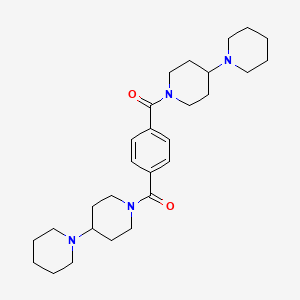


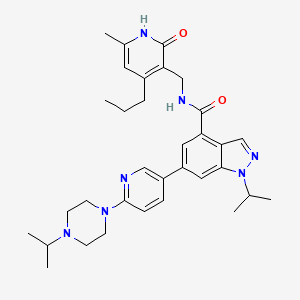

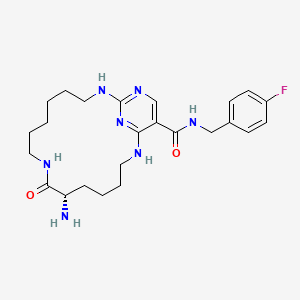
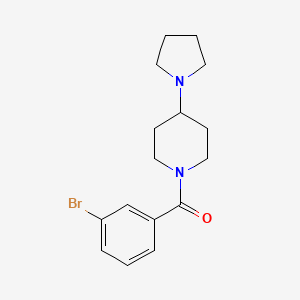
![5-[3-[4-(2,3-dichlorophenyl)piperidin-1-yl]propoxy]-1,3-benzothiazole;hydrochloride](/img/structure/B611587.png)
